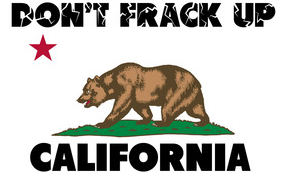 “Fracking” is the abbreviation for “hydraulic fracturing”. It is a technique whereby oil, natural gas, other substances or heat energy in shale/rock are liberated by deep wells-- often to well over 10,000 feet-- both dug vertically and sideways (“directional drilling”), the wells being injected by water and sand/ceramics/other solid “inert” materials (“proppant”) laced with many chemicals, including nuclear plant cooling waste water, under high pressure (“slickwater fracturing” developed in 1997) to fracture the shale. Many of these chemicals can cause a wide range of health problems. Fracking was responsible for 49% of gas production in the U.S. in 2010. A noted fracking site blow-out occurred in Clearfield County, Pennsylvania on June 3 2010 resulting in 35,000 gallons of acidic fracking fluid being released into the air. Recent data have indicated a connection between fracking and a rare Richter 5.7 earthquake in Oklahoma although this is disputed. Extraction water injection is also linked with earthquakes.
“Fracking” is the abbreviation for “hydraulic fracturing”. It is a technique whereby oil, natural gas, other substances or heat energy in shale/rock are liberated by deep wells-- often to well over 10,000 feet-- both dug vertically and sideways (“directional drilling”), the wells being injected by water and sand/ceramics/other solid “inert” materials (“proppant”) laced with many chemicals, including nuclear plant cooling waste water, under high pressure (“slickwater fracturing” developed in 1997) to fracture the shale. Many of these chemicals can cause a wide range of health problems. Fracking was responsible for 49% of gas production in the U.S. in 2010. A noted fracking site blow-out occurred in Clearfield County, Pennsylvania on June 3 2010 resulting in 35,000 gallons of acidic fracking fluid being released into the air. Recent data have indicated a connection between fracking and a rare Richter 5.7 earthquake in Oklahoma although this is disputed. Extraction water injection is also linked with earthquakes.
The first industrial use of fracking was in 1903, the first systematic experimental field fracking was in 1947, and the first commercially successful application in 1949 was patented by Haliburton. The related practice of injecting extraction wastewater (not under pressure) into cavities left by the extracted oil and gas is even older. As of 2010, it was estimated that 60% of all new oil and gas wells worldwide were being hydraulically fractured.
Fracking has been done in California for decades. However today's high pressure technologies present far greater danger and risk, and companies are pushing to increase fracking tens to hundreds of times (for example, in the Monterey Shale of central California and near San Luis Obispo ( an area of 1,750 square miles) with estimated recoverable oil reserves of 15 billion barrels of oil worth about $1,500 billion assuming a barrel of oil is worth $100.) Demonstrations against the indiscriminant use of fracking have occurred in many California cities such as Los Angeles; San Francisco; Oakland; Sacramento; and Fresno. California is the fourth largest oil producing state in the United States after North Dakota (Bakken Shale formation is currently being fracked), Texas (the Cotton Valley sandstone, Barnett Shale/Pearsall Shale Basins are being fracked), and Alaska.
The current California fracking and extraction wastewater injection approval process is a prime example of the non-application of the GPCA
Green Science and
Water platforms.
France banned hydraulic fracking in 2011. The Green Party of California agrees.
The Green Party of California proposes:
 1.
1. Because any further expansion of fossil fuel extraction and use on the Earth will dangerously increase green house gas emissions, and because fracking of fossil fuels creates even higher such emissions than traditional fossil fuel extraction, and because it is not possible to perform hydraulic fracturing without creating severe environmental damage and toxic contamination of air, water and ecosystems; and because earthquake potential will also be increased; therefore the Green Party of California supports a moratorium leading to a permanent ban on all forms of fracking in the state of California and in the United States. We also call for the same ban on all extraction wastewater injection when not used for aquifer recharge purposes that are in line with California’s water standards.
The proposal is in line with the 2012 Green Party of the United States
National Platform on fracking: “Enact a moratorium on hydraulic fracturing (“fracking”) until its damaging effects on water and air quality are fully studied and understood. Permanently ban high-volume hydraulic fracturing in sensitive watersheds. Regulate hydraulic fracturing under the Safe Drinking Water Act, Clean Water Act and National Environmental Policy Act, and require public disclosure of the chemicals used in fracturing fluids.” The Green Party of California wants ultimately to go further than this position by banning fracking and extend that to extraction wastewater injection except for aquifer recharge purposes that are in line with California’s water standards.
2. While not condoning the practice of fracking, polluting companies must be held responsible for the property and health damage costs of previous and current fracking and extraction waste water injection.
3. Health professionals, government agencies and the public must be allowed full and immediate access to all the chemical information about fracking fluids, proppants, extraction wastewater injection fluid, and contamination and pollution data for their patients exposed in fracked areas or those exposed on extraction wastewater injected land.
4. The State of California and the United States should emphasize renewable energy sources rather than carbon or nuclear sources.
 “Fracking” is the abbreviation for “hydraulic fracturing”. It is a technique whereby oil, natural gas, other substances or heat energy in shale/rock are liberated by deep wells-- often to well over 10,000 feet-- both dug vertically and sideways (“directional drilling”), the wells being injected by water and sand/ceramics/other solid “inert” materials (“proppant”) laced with many chemicals, including nuclear plant cooling waste water, under high pressure (“slickwater fracturing” developed in 1997) to fracture the shale. Many of these chemicals can cause a wide range of health problems. Fracking was responsible for 49% of gas production in the U.S. in 2010. A noted fracking site blow-out occurred in Clearfield County, Pennsylvania on June 3 2010 resulting in 35,000 gallons of acidic fracking fluid being released into the air. Recent data have indicated a connection between fracking and a rare Richter 5.7 earthquake in Oklahoma although this is disputed. Extraction water injection is also linked with earthquakes.
“Fracking” is the abbreviation for “hydraulic fracturing”. It is a technique whereby oil, natural gas, other substances or heat energy in shale/rock are liberated by deep wells-- often to well over 10,000 feet-- both dug vertically and sideways (“directional drilling”), the wells being injected by water and sand/ceramics/other solid “inert” materials (“proppant”) laced with many chemicals, including nuclear plant cooling waste water, under high pressure (“slickwater fracturing” developed in 1997) to fracture the shale. Many of these chemicals can cause a wide range of health problems. Fracking was responsible for 49% of gas production in the U.S. in 2010. A noted fracking site blow-out occurred in Clearfield County, Pennsylvania on June 3 2010 resulting in 35,000 gallons of acidic fracking fluid being released into the air. Recent data have indicated a connection between fracking and a rare Richter 5.7 earthquake in Oklahoma although this is disputed. Extraction water injection is also linked with earthquakes. 1. Because any further expansion of fossil fuel extraction and use on the Earth will dangerously increase green house gas emissions, and because fracking of fossil fuels creates even higher such emissions than traditional fossil fuel extraction, and because it is not possible to perform hydraulic fracturing without creating severe environmental damage and toxic contamination of air, water and ecosystems; and because earthquake potential will also be increased; therefore the Green Party of California supports a moratorium leading to a permanent ban on all forms of fracking in the state of California and in the United States. We also call for the same ban on all extraction wastewater injection when not used for aquifer recharge purposes that are in line with California’s water standards.
1. Because any further expansion of fossil fuel extraction and use on the Earth will dangerously increase green house gas emissions, and because fracking of fossil fuels creates even higher such emissions than traditional fossil fuel extraction, and because it is not possible to perform hydraulic fracturing without creating severe environmental damage and toxic contamination of air, water and ecosystems; and because earthquake potential will also be increased; therefore the Green Party of California supports a moratorium leading to a permanent ban on all forms of fracking in the state of California and in the United States. We also call for the same ban on all extraction wastewater injection when not used for aquifer recharge purposes that are in line with California’s water standards.



